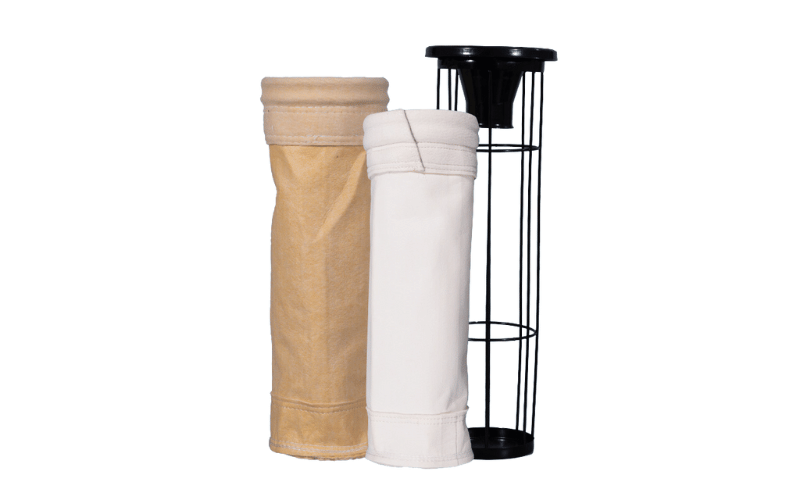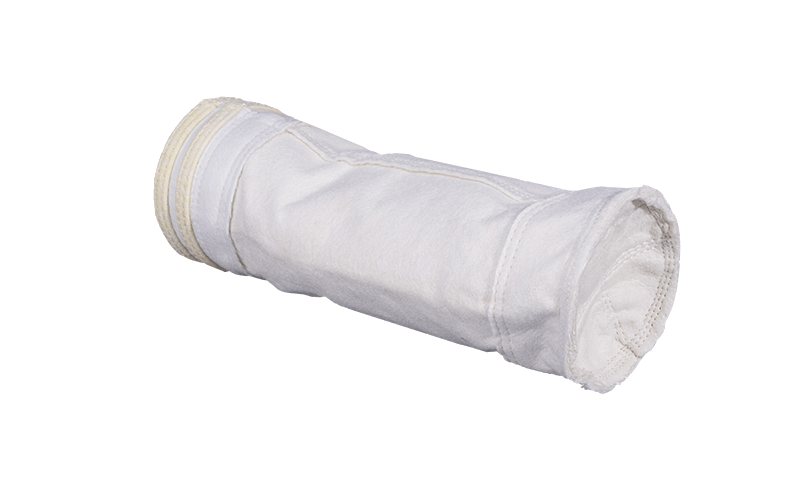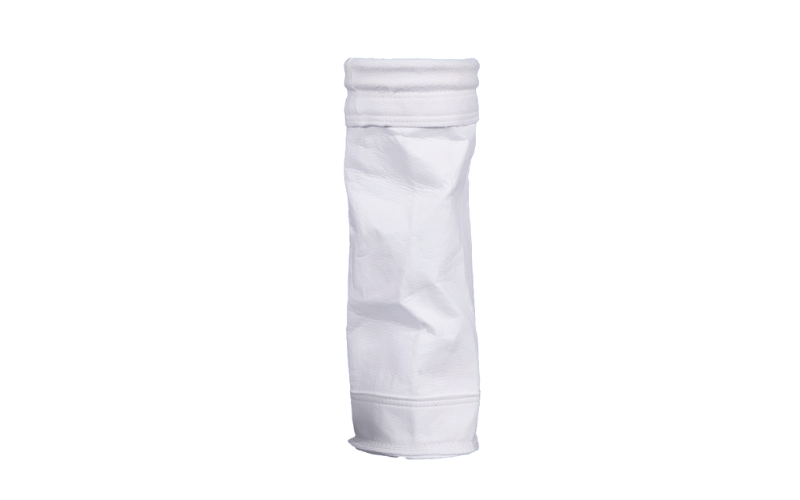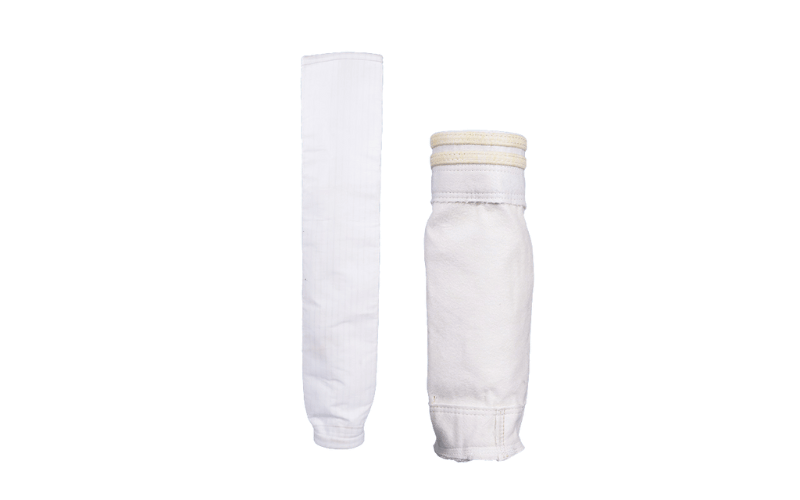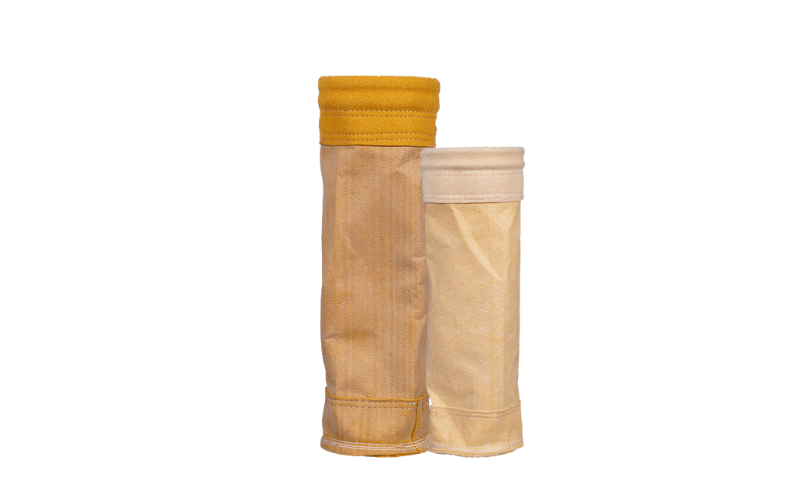Needle Felt Filter Bag
Home » Dust Filter Bag » Needle Felt Filter Bag
Efficient Filtration | Long Service Life | Customizable Options
Our Needle Felt Filter Bags are crafted using a precise needle-punching process that interlocks fibers to form a durable, thick filter layer. The primary materials include polyester, PPS, fluorocarbon, and other high-performance fibers, specially treated to deliver exceptional properties such as high-temperature resistance, corrosion resistance, and wear resistance.
Performance Characteristics
- High Filtration Efficiency: Delivers superior filtration results tailored to meet diverse industrial requirements.
- Excellent Air Permeability: Facilitates optimal airflow without compromising filtration performance.
- Superior Durability: Engineered for high mechanical strength to withstand prolonged use in demanding environments.
- Chemical and Wear Resistance: Withstands exposure to harsh acids, alkalis, and abrasive particulates for reliable long-term operation.
Technical Specifications
| Parameter | Specification |
|---|---|
| Name | Nomex Filter Bags |
| Material | Aramid Fiber/Aramid Base Cloth |
| Weight | 500 g/m² |
| Air Permeability | 80-100 m³/m²/s |
| Warp Tension | 800 N/5x20 cm |
| Weft Tension | 1200 N/5x20 cm |
| Warp Elongation | 20% |
| Weft Elongation | 50% |
| Operating Temperature | Continuous: ≤204°C, Instantaneous: ≤240°C |
| Filtering Air Velocity | 1.0~1.2 m/min |
What are the benefits of using a needle felt filter bag?
The main benefits of using needle felt filter bags include the following:
- Excellent breathability: Needle felt filter bags are made of fine-denier fibers and a three-dimensional spatial structure, with a porosity of up to 70%-80%, which is 1.6-2.0 times that of general woven filter materials. This structure makes the filter bags highly breathable, with low operating resistance, effectively reducing equipment energy consumption and improving filtration efficiency.
- Exceptional wear resistance: Polyester fibers inherently possess high strength and excellent elastic recovery properties. Combined with a base fabric woven from high-strength, low-elongation yarns, the filter bags exhibit outstanding wear resistance. After needle-punch reinforcement and post-treatment processes, the filter bag surface becomes smooth and flat, further enhancing its abrasion resistance and making it suitable for high dust concentrations and complex operating conditions.
- High filtration efficiency: The fibers in Needle Felt Filter Bags are uniformly arranged with a rational pore distribution, forming a stable dust layer that ensures consistent and high dust capture efficiency. Their filtration precision meets the stringent requirements for dust emissions in industrial production, effectively improving air quality.
- Excellent chemical stability: Polyester filter bags are resistant to acids, alkalis, and hydrolysis, making them suitable for various chemical environments. Through surface treatments (such as water-repellent, oil-repellent, and anti-static), their corrosion resistance and service life can be further enhanced, reducing maintenance costs.
- Temperature Resistance: Needle-felt filter bags have moderate temperature resistance, capable of withstanding temperatures up to 150°C for short periods. They exhibit moderate resistance to acids and alkalis and excellent abrasion resistance.
- Long Service Life: The design and material selection of Needle Felt Filter Bags ensure a long service life, reducing replacement frequency and maintenance costs.
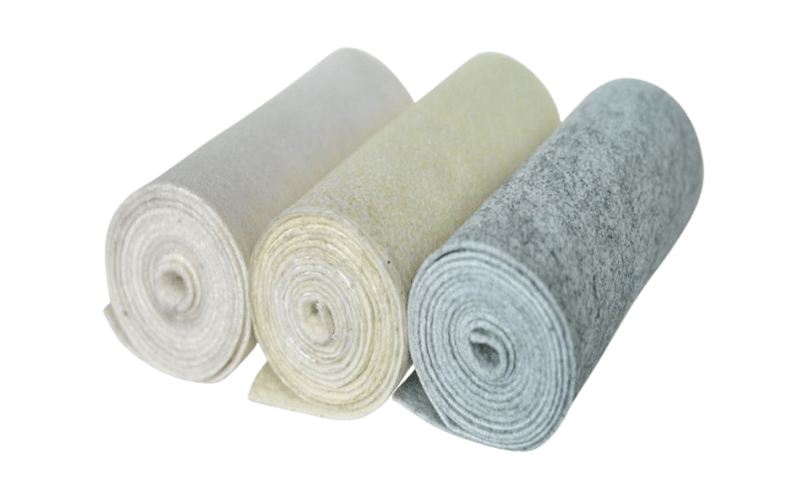
What is a Needle Felt Filter Bag?
A needle-felt filter bag is a high-quality filtration product designed to meet the rigorous demands of industrial processes. These bags are made from needle-punched felt materials, forming a durable, high-strength fabric that effectively captures fine particles from air or liquid streams. Designed with precision and advanced manufacturing techniques, our needle felt filter bags provide exceptional filtration performance, ensuring cleaner production environments and improved product quality. They are widely recognized for their versatility and effectiveness in various filtration applications.
Understanding Needle Felt Material
Needle felt is a specialized fabric created through a needle-punching process that mechanically intertwines fibers to form a dense and robust structure. This process yields a fabric with a specific thickness, strength, and porosity, making it suitable for industrial filtration applications. The base materials for needle felt typically include high-performance fibers such as polyester (PE), polypropylene (PP), PPS, or polyimide (PI). For enhanced durability and versatility, additional treatments like PTFE coating, calendering, or water and oil repellency can be applied to the material.
Key characteristics of needle felt material include:
- High Filtration Efficiency: The dense fabric structure supports effective particle capture while maintaining airflow.
- Mechanical Strength: Its robust construction withstands abrasive environments and prolonged use.
- Chemical Resistance: It resists damage from exposure to acids and alkalis, ensuring reliability in harsh conditions.
- Thermal Stability: Selected materials can operate over a wide range of temperatures, catering to the demanding needs of various industrial applications.
Applications of Needle Felt Filter Bags
Our needle felt filter bags provide indispensable solutions across various industries, thanks to their adaptability and high filtration performance. Key application areas include:
- Industrial Dust Removal: Needle felt filter bags excel in dust collection systems, such as baghouse filters, capturing airborne particulates in industries such as cement, steel, and power generation.
- Liquid Filtration: Ideal for filtering suspended solids from fluid streams in chemical processing, food and beverage production, and water treatment facilities.
- Exhaust Gas Filtration: Effectively captures pollutants and particulates from industrial exhaust gases, ensuring compliance with environmental emission standards.
- Pharmaceutical and Food Safety: Used in sensitive applications to enhance cleanliness and product integrity during manufacturing.
By implementing these filter bags into their systems, industries can ensure cleaner processes, extend equipment life, and achieve regulatory compliance.
How Needle Felt Filter Bags Work?
Our needle felt filter bags function by leveraging the properties of surface filtration and depth filtration. The surface layer traps larger particles, while the thickness of the needle felt enables it to capture finer particulates within the fabric layers. This dual-action approach ensures high efficiency and reliability for a wide range of filtration requirements.
Key steps in the filtration process:
- Particle Capture: Air or liquid passes through the filter bag, where particles are intercepted and retained on or within the filter media.
- Maintenance of Airflow: The air permeability of the needle felt ensures the continuous flow of air or liquid while maintaining filtration efficiency.
- Dust Cake Formation (for air filtration): Over time, particulates accumulate to form a dust cake on the bag’s surface, enhancing filtration performance. This cake can be cleaned during maintenance.
- Cleaning and Replacement: Regular cleaning methods, such as compressed air backblowing or pulse-jet cleaning, maintain efficiency. When needed, the bags can be replaced to ensure consistent performance.
These bags are engineered to perform reliably in extreme conditions, including high temperatures, chemically aggressive environments, and abrasive settings. Their innovative design maximizes filtration efficiency while minimizing energy consumption and operational costs.
How do felt filter bags differ from other filter options?
Felt filter bags stand out as a highly versatile and efficient filtration solution compared to other filter options in the market. The key distinction lies in their unique fabric composition and design, which enable both surface and depth filtration. Unlike woven filters, which primarily rely on surface barriers, felt filter bags leverage a needle-punched, interlocking fiber structure. This combination ensures superior particulate retention while maintaining excellent airflow or liquid flow rates.
Our felt filter bags are engineered explicitly for industrial environments where high filtration efficiency, durability, and chemical resistance are critical. They can accommodate larger dirt-holding capacities without frequent maintenance, setting them apart from other filter options like mesh filters or rigid cartridges.
Comparing Felt Filter Bags with Bag Filters
When evaluating felt filter bags against other types of bag filters, such as mesh or membrane-based varieties, several key differences emerge:
1. Filtration Mechanism
- Felt Filter Bags: utilize a dual-action surface and depth filtration, capturing both large and fine particles within the fabric layers. This enhances dirt-holding capacity and extends operational life.
- Mesh Filter Bags: Rely solely on surface filtration, making them effective only for applications requiring the retention of larger particulates.
- Membrane Filters: Designed for fine filtration, but often have higher operational costs and lower flow rates due to restrictive pore sizes.
2. Material Durability
Felt filter bags offer superior mechanical strength and resistance to harsh industrial conditions, including high temperatures and exposure to aggressive chemicals, unlike mesh filters, which are less robust in such environments.
3. Versatility
Compared to traditional bag filters, felt filter bags excel in handling a wider range of applications due to their adaptability and optional material treatments, such as PTFE coating or water repellency.
Advantages of Needle Felt Filter Technology
Our needle felt filter technology offers several advantages that make it an ideal choice for diverse industrial filtration needs:
- High Filtration Efficiency: The tightly entangled fibers of needle felt create a dense filtration medium that captures fine particulates while maintaining optimal permeability.
- Improved Dirt-Holding Capacity: The depth filtration capability ensures that particles are trapped within the layers of the felt, reducing the frequency of bag replacement and minimizing downtime.
- Durability and Longevity: Advanced needle-punching techniques result in a fabric that withstands abrasive environments, mechanical stress, and chemical exposure.
- Customizable Filter Characteristics: Needle felt filter bags can be tailored to meet specific industrial requirements, with customizable pore sizes, thicknesses, and treatments like oil and water repellency.
These benefits translate to cost savings, enhanced process efficiency, and reliable performance in demanding applications.
Common Materials Used in Felt Filter Bags
The effectiveness of our felt filter bags is primarily determined by the quality and type of materials used in their fabrication. Each material offers distinct advantages, making it suitable for specific industrial challenges:
1. Polyester (PE)
- Properties: High tensile strength, excellent dimensional stability, and resistance to many chemicals.
- Applications: Suitable for most general industrial filtration applications, including dust collection and liquid filtration.
2. Polypropylene (PP)
- Properties: Outstanding chemical resistance, particularly to acids and alkalis, and a low-cost option for many uses.
- Applications: Ideal for liquid filtration, chemical processing, and water treatment.
3. PPS (Polyphenylene Sulfide)
- Properties: Superior thermal resistance and chemical tolerance, making it ideal for high-temperature applications.
- Applications: Commonly used in power plants, cement production, and other processes generating hot gases with chemical contaminants.
4. Polyimide (PI)
- Properties: Excellent resistance to high temperatures and mechanical stress, combined with chemical resilience.
- Applications: Suitable for extreme industrial environments like metal smelting and incineration plants.
5. PTFE-Coated Felt
- Properties: Enhanced chemical resistance and non-stick properties, facilitating easy cleaning and extended service life.
- Applications: Utilized in industries requiring stringent emissions control, such as pharmaceutical or petrochemical operations.
By selecting the appropriate material, we ensure that our felt filter bags consistently deliver optimal filtration performance, durability, and reliability across a wide array of industrial applications.
What is the filtration capacity of needle felt filter bags?
Our needle felt filter bags are designed with precision engineering to deliver exceptional filtration performance, catering to the specific requirements of industrial applications. The filtration capacity of these bags is determined by their ability to capture particles of varying sizes while maintaining efficient air or liquid flow. Thanks to the unique needle-punching process that creates a dense, interlocking fiber matrix, our filter bags capture both coarse and fine particulates with high efficiency.
We offer needle felt filter bags with filtration capabilities ranging from standard particulate collection up to capturing wonderful particles, ensuring versatility for diverse industrial needs. The filtration capacity can be customized to suit specific applications, with various micron ratings available to match industry standards for air quality or liquid purity.
Understanding Micron Ratings
Micron ratings are a critical factor in understanding the efficiency and applicability of our needle felt filter bags. These ratings quantify the size of particles the filter material can capture, expressed in micrometers (µm). For example, a filter with a 10-micron rating can capture particles as small as 10 micrometers.
Our needle felt filter bags are available in a range of micron ratings to meet specific operational needs:
- Low Micron Ratings (1-10 µm): Ideal for applications requiring fine particulate removal, such as pharmaceutical production or precision liquid filtration.
- Medium Micron Ratings (10-50 µm): Suitable for moderate filtration needs, including industrial dust collection and wastewater treatment.
- High Micron Ratings (50-200 µm): Designed for coarse filtration in applications like solid-liquid separation or bulk air filtration.
The high flexibility in micron selection allows us to tailor the filtration performance to meet stringent industry requirements, ensuring that your processes operate efficiently and safely.
Holding Capacity and Retention Rates
Our needle felt filter bags excel in holding capacity and retention rates, making them a cost-effective solution for filtration needs. Holding capacity refers to the volume of particulates the filter bag can retain before it requires maintenance or replacement. Retention rate, on the other hand, measures the percentage of particulates effectively captured by the filter material.
Key Advantages of Our Needle Felt Filter Bags:
- High Dirt-Holding Capacity: The dense fiber structure and multi-layer design enable our bags to capture and retain significant amounts of particulates without frequent replacements. This reduces downtime and operational costs.
- Efficient Retention Rate: Thanks to the needle-punching process, our filter bags achieve high retention rates, ensuring that even fine particles are trapped effectively. This results in cleaner air or liquid output.
- Consistent Performance Over Time: The robust design of our filter bags ensures that they maintain their holding and retention capabilities even under prolonged use and harsh environmental conditions.
The optimal balance of high holding capacity and efficient retention rates makes our needle felt filter bags a dependable choice for demanding industrial applications.
Industry Standards for Needle Felt Filter Bags
We ensure that all our needle felt filter bags meet or exceed industry standards, providing you with reliable, high-quality filtration solutions. Adherence to these standards not only guarantees excellent performance but also ensures compliance with regulatory requirements across various industries.
Key Standards We Comply With:
- ISO 16890: This international standard measures the filtration efficiency of particulate air filters, ensuring performance in industrial air filtration applications.
- ASHRAE Standards: Our filter bags conform to ASHRAE test methods for effective fine and coarse particle retention in HVAC and other air systems.
- US EPA Standards: For applications involving emissions control, our filter bags help industries comply with environmental regulations for permissible dust and particulate levels.
- FDA Compliance (for liquid filtration): For food, beverage, and pharmaceutical applications, we use materials that meet FDA requirements for contaminants and purity.
- EN Standards for Dust Collectors: Our products align with European safety and performance standards, ensuring suitability in globally regulated industries.
By adhering to such industry benchmarks, we ensure that our needle felt filter bags serve as a reliable and efficient solution across a wide range of applications. Combined with our expertise in material selection and precision design, you can trust us to deliver filtration solutions tailored to your specific operational needs.
How to properly maintain and handle needle felt filter bags?
Proper maintenance and careful handling are essential to maximize the longevity and performance of our needle felt filter bags. By following industry-recommended practices, you can ensure that your filtration systems operate efficiently while reducing downtime and replacement costs. Our needle felt filter bags are built to withstand rigorous applications, but a proactive approach to their care can further enhance their durability and effectiveness.
Installation Tips for Filter Bags
Installing your needle felt filter bags correctly is the first step toward achieving optimal filtration results. Improper installation can lead to inefficiencies and potentially damage the filter bags or the equipment. Here are some essential tips for a seamless installation process:
- Inspect the Filtration System: Before installation, thoroughly inspect the filtration system to ensure there are no sharp edges, residues, or obstructions that could damage the filter bag.
- Verify Size and Fit: Ensure that the filter bag matches the dimensions and specifications of your filtration unit. A snug and secure fit is critical for preventing bypass issues.
- Position the Bag Correctly: Align the bag properly within the cage or housing, ensuring it is evenly supported and tensioned. This prevents sagging or improper airflow.
- Seal the Perimeter: Make sure all seals or gaskets are correctly positioned to create an airtight connection. This prevents unfiltered air or liquid from bypassing the filtration media.
- Follow Manufacturer Guidelines: Adhere to the specific installation instructions provided in the product documentation for your filtration system and filter bags.
By taking the time to perform a precise installation, you can avoid operational inefficiencies and premature wear on your needle felt filter bags.
Cleaning and Maintenance Routines
Regular cleaning and maintenance ensure that our needle felt filter bags maintain their filtration efficiency over an extended period. The frequency and method of cleaning will depend on the application and the nature of the particulates being filtered. Below are general guidelines:
- Monitor Pressure Drop: Use system readings, such as pressure drop indicators, to assess when the filter bag requires cleaning. A consistent increase in pressure drop may signal buildup within the bag.
- Opt for Automated Cleaning Systems: Most industrial systems are equipped with automated cleaning mechanisms, such as reverse air, pulse-jet, or shaker systems, that effectively dislodge dust or debris from the bag’s surface. Ensure these systems are operating correctly and as intended.
- Manual Cleaning: For systems without automated cleaning features, manual cleaning may be required. Remove the filter bag carefully and shake it to dislodge accumulated particulates. Avoid using high-pressure tools that could damage the fibers.
- Inspect During Cleaning: Periodically inspect the bag during cleaning routines for signs of wear, such as thinning fabric or holes, which could compromise filtration performance.
- Avoid Harsh Cleaning Agents: If washing is needed, use gentle, manufacturer-approved detergents and avoid chemical solvents that could weaken the fibers or reduce resistance properties.
Implementing a regular maintenance schedule tailored to your system’s needs will help preserve the integrity and efficiency of your filter bags.
Signs That It’s Time to Replace Your Felt Filter Bag
Despite proper maintenance, all filter bags have a finite service life. Recognizing the signs of wear or diminished performance ensures your filtration system continues to operate effectively. Here are key indicators that it’s time to replace your needle felt filter bag:
- Decreased Filtration Efficiency: If you notice an increase in particulate emissions or reduced filtering performance, this signals that the fibers may no longer be capturing particulates as effectively.
- Persistent Pressure Drop: A filter bag that retains significant resistance to airflow or liquid flow after cleaning may indicate clogging or degraded porosity.
- Visible Damage or Wear: Inspect filter bags for any physical damage, including tears, holes, or frayed edges. These can allow contaminants to bypass the filtration system.
- Reduced Bag Integrity: Look for signs of material fatigue, such as thinning fabric, brittleness, or a distorted structure due to extreme conditions.
- Frequent Cleaning Needs: If cleaning intervals become unusually short, this may imply that the bag’s holding capacity is compromised, and replacement is necessary.
When any of these signs are evident, it is critical to replace the filter bag promptly to avoid operational inefficiencies or damage to downstream systems. We recommend documenting routine inspections and maintaining an inventory of replacement bags to ensure minimal downtime when replacements are required.
By investing time in proper maintenance and timely replacements, you can extend the lifespan of your filtration system while achieving consistent, high-quality performance with our needle felt filter bags. For further guidance, feel free to reach out to our technical support team—we’re here to assist you every step of the way.
FAQ: Needle Felt Filter Bags
Q: What are needle felt filter bags made from?
A: Our needle felt filter bags are crafted from durable materials like polypropylene and polyester, offering excellent filtration performance for diverse applications. Additionally, we provide options made from Aramid Fiber or Aramid Base Cloth, which deliver enhanced resistance to high temperatures and harsh chemical environments. These materials ensure reliable, long-lasting performance in even the most demanding conditions.
Q: How do needle felt filter bags perform in terms of dirt holding capacity?
A: Needle felt filter bags offer excellent dirt holding capacity, efficiently capturing a wide range of particles while maintaining consistent and optimal flow rates. This ensures extended service life and reduced downtime for maintenance.
Q: Are needle felt filter bags compliant with food and beverage regulations?
A: Yes, our needle felt filter bags comply with stringent food and beverage industry standards. They are designed and manufactured for safe use in sensitive applications, including water treatment and beverage filtration processes.
Q: What is the typical filtration range of needle felt filter bags?
A: Needle felt filter bags come in a variety of micron ratings, ranging from as fine as 1 micron to larger particle sizes. This allows precise and tailored filtration for specific operational needs across diverse industries.
Q: Can needle felt filter bags be used in bag filter housing systems?
A: Absolutely. Our needle felt filter bags are engineered to fit seamlessly into standard bag filter housing systems, making them a versatile and effective solution for various liquid filtration applications.
Q: What materials are used to construct the filter media in these bags?
A: The filter media is typically made from polypropylene or polyester felt. These materials ensure effective particle removal, high flow rates, and exceptional durability under a range of operating conditions.
Q: How are the seams on needle felt filter bags constructed?
A: The seams are crafted using advanced sewing and welding techniques. This combination produces strong, leak-proof seams that enhance the bag's integrity and performance during operation.
Q: What are the advantages of using nylon monofilament in needle felt filter bags?
A: Nylon monofilament improves the mechanical strength of the filter bags and minimizes fiber migration, ensuring consistent filtration performance. Its robust nature helps extend the lifespan of the bags even under demanding uses.


